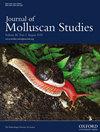结节扇贝视觉系统的左-右不对称性(双壳目:果胶科)
IF 1.2
4区 生物学
Q2 MARINE & FRESHWATER BIOLOGY
引用次数: 0
摘要
左右不对称是左右两侧的一致差异,代表了软体动物形态的一个有趣特征。有趣的是,外部不对称,如不等瓣壳,通常与神经系统的侧化相结合,这通常包括左侧或右侧的功能和结构专门化。在视觉不对称的情况下,偏侧表型通常包括眼睛位置、结构和使用方面的左右差异。为了研究双壳类动物的侧化和视觉不对称,我们检查了结节扇贝的视觉和神经系统。我们对该物种不同的眼睛形态进行了表征,并确定了眼侧频率。我们还研究了神经系统的解剖学,重点是顶脏神经节(PVG)。我们的研究结果表明,结节扇贝的视觉和神经系统包括一致的左右不对称:(1)左侧有更多的眼睛,(2)左侧PVG侧叶的大小增加,(3)左PVG侧叶中较大的肾小球,以及(4)与左侧叶相关的桡侧皮质神经比与右侧叶相关联的排列更紧凑的皮质神经间隔更宽。此外,具有独特形态的眼睛(视小泡旋转)在左侧更常见。考虑到该物种在右瓣膜上休息的习惯,我们假设弯曲的眼睛可能有助于扩大整个视野。尽管在关于侧化的文献中通常不考虑双壳类,但正如我们的研究结果所表明的,扇贝的证据不断积累,表明它们有可能揭示底栖无脊椎动物视觉不对称的新模式。本文章由计算机程序翻译,如有差异,请以英文原文为准。
Left–right asymmetry of the visual system in the scallop Nodipecten nodosus (Bivalvia: Pectinidae)
Left–right asymmetries are consistent differences between the left and right sides and represent an intriguing feature of molluscan morphology. Interestingly, external asymmetries, such as inequivalve shells, are often coupled with lateralization in the nervous system, which often includes functional and structural specializations of the left or right sides. In the case of visual asymmetries, lateralized phenotypes frequently include left–right differences in eye position, structure and use. To investigate lateralization and visual asymmetries among bivalves, we examined the visual and nervous systems of the scallop Nodipecten nodosus. We characterized different eye morphologies in the species and determined eye-side frequencies. We also studied the anatomy of the nervous system, focusing on the parietovisceral ganglion (PVG). Our results reveal that the visual and nervous systems of the scallop N. nodosus comprise consistent left–right asymmetries: (1) a greater number of eyes on the left side, (2) increased size of the left PVG lateral lobe, (3) larger glomeruli in the left PVG lateral lobe and (4) radial pallial nerves associated with the left lateral lobe spaced more widely than the more compactly arranged pallial nerves associated with the right lateral lobe. In addition, eyes with a distinctive morphology, where the optic vesicle is rotated, are more frequent on the left side. Considering the habit of this species to rest on the right valve, we hypothesize that curved eyes might contribute to expanding the overall visual field. Even though bivalves are not typically considered in the literature on lateralization, accumulating evidence for scallops, as suggested by our results, indicates their potential to reveal novel patterns of visual asymmetry in benthic invertebrates.
求助全文
通过发布文献求助,成功后即可免费获取论文全文。
去求助
来源期刊

Journal of Molluscan Studies
生物-动物学
CiteScore
3.00
自引率
8.30%
发文量
36
审稿时长
3 months
期刊介绍:
The Journal of Molluscan Studies accepts papers on all aspects of the study of molluscs. These include systematics, molecular genetics, palaeontology, ecology, evolution, and physiology. Where the topic is in a specialized field (e.g. parasitology, neurobiology, biochemistry, molecular biology), submissions will still be accepted as long as the mollusc is the principal focus of the study, and not incidental or simply a convenient experimental animal. Papers with a focus on fisheries biology, aquaculture, and control of molluscan pests will be accepted only if they include significant advances in molluscan biology. While systematic papers are encouraged, descriptions of single new taxa will only be considered if they include some ‘added value’, for example in the form of new information on anatomy or distribution, or if they are presented in the context of a systematic revision or phylogenetic analysis of the group.
 求助内容:
求助内容: 应助结果提醒方式:
应助结果提醒方式:


